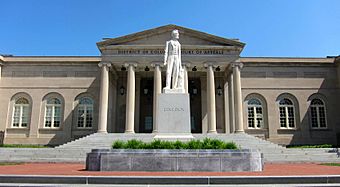District of Columbia City Hall facts for kids
|
District of Columbia City Hall
|
|
 |
|
| Location | 451 Indiana Avenue NW Washington, D.C. |
|---|---|
| Built | 1820 |
| Architectural style | Neoclassical |
| NRHP reference No. | 66000857 |
Quick facts for kids Significant dates |
|
| Added to NRHP | October 15, 1966 |
| Designated NHL | December 19, 1960 |
The District of Columbia City Hall, also known as "Old City Hall", is a historic building. It stands in Judiciary Square in downtown Washington, D.C.. This building was first used for the District of Columbia government offices. Later, it became a Federal courthouse. It was the location for several important trials. The building was named a National Historic Landmark in 1960. Today, it is home to the District of Columbia Court of Appeals.
Contents
History of the Old City Hall
Designing a New Government Building
In 1818, the government of Washington, D.C., decided to build a new district building. They held a competition to find the best design. George Hadfield was an architect who had worked on the United States Capitol. He submitted a design, but it was too expensive.
Construction Begins and Continues
Hadfield won the competition in 1820 with a simpler plan. Construction started in August of that year. The district government offices moved into the building in 1822. However, there were not enough funds to finish the building quickly. The entire building was not completed until 1849.
Sharing the Space for Funding
To help pay for the building, the district rented out parts of it. Other federal government offices used the space. One tenant was the U.S. Circuit Court. The Recorder of Deeds office was also there. This office was led by Frederick Douglass, a famous Black leader. He worked to end slavery.
A Place for Important Changes
After the District of Columbia Compensated Emancipation Act passed in 1862, the Old City Hall had a special role. It was used to process payments to people who had owned enslaved people. This act freed enslaved people in Washington, D.C.
Federal Ownership and New Uses
In 1863, during the American Civil War, the federal government rented more space. Later, they bought the building from the District government. It became home to the Supreme Court of the District of Columbia. In 1868, a statue of President Abraham Lincoln was placed outside. This was the first public monument honoring him.
The District of Columbia government moved to the new District Building in 1908. The Old City Hall then housed only the federal courts until 1910.
Renovation and Modern Use
In 1916, Congress approved money to fully renovate the building. Its outer walls were replaced with limestone. In 1922, it was rededicated as the U.S. Courthouse. The federal courts moved to a new building in 1952. The Old City Hall then became the main office for the U.S. Selective Service System.
The building was named a National Historic Landmark in 1960. Two years later, it returned to the District government. It began to be used by the local courts.
Significant Events at the Courthouse
Many important legal events happened at the Old City Hall. This was when it served as a U.S. courthouse.
Trials of Historical Figures
In 1832, former Tennessee Governor Sam Houston had a legal dispute there. He was tried after a disagreement with a member of Congress.
In 1835, a trial took place following a serious incident involving President Andrew Jackson. The prosecutor was Francis Scott Key, who wrote "The Star-Spangled Banner."
The building was also the site of a trial in 1867. This trial was connected to a major event involving President Abraham Lincoln. In 1882, another significant trial related to President James A. Garfield happened here.
The Pearl Incident
The Old City Hall was also the scene of a trial known as the "Pearl incident." This was the largest single attempt by enslaved people to escape in U.S. history. In 1848, two men were tried. They had tried to help more than 70 enslaved people escape. They planned to sail them from Washington, D.C., down the Potomac River and up the Chesapeake Bay.
Current Use of the Building
In 1999, the building closed for a big renovation. The inside was updated, but the stone outside stayed the same. A new glass atrium was built on the north side. This atrium is now the main entrance. On June 17, 2009, the building was rededicated. It is now the home of the District of Columbia Court of Appeals.
Images for kids




